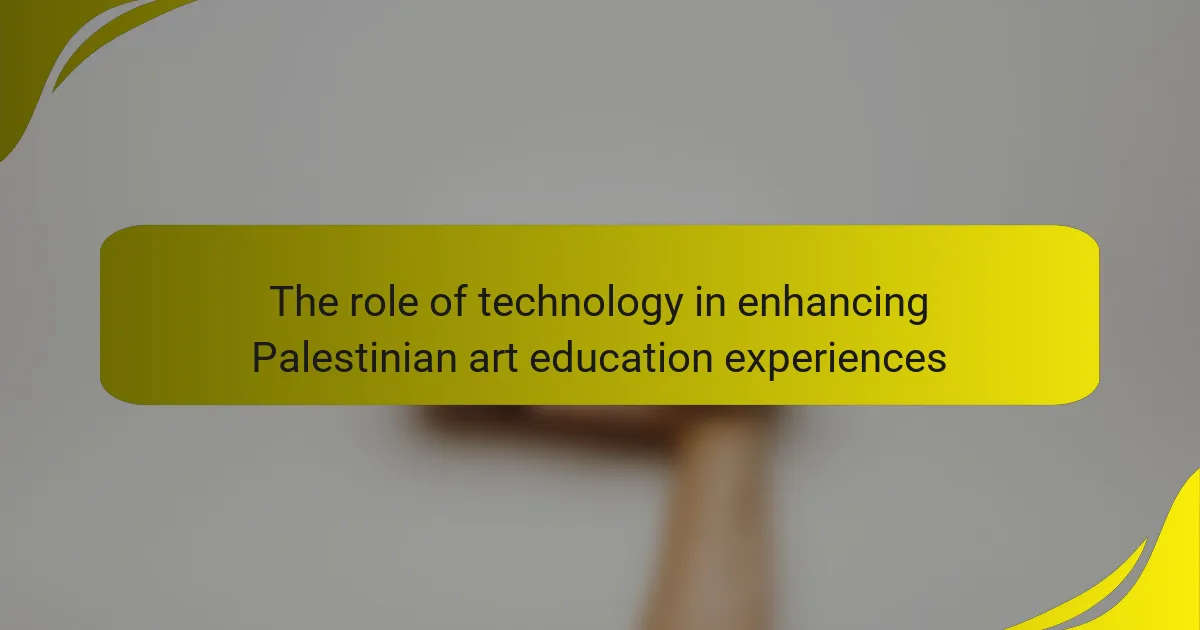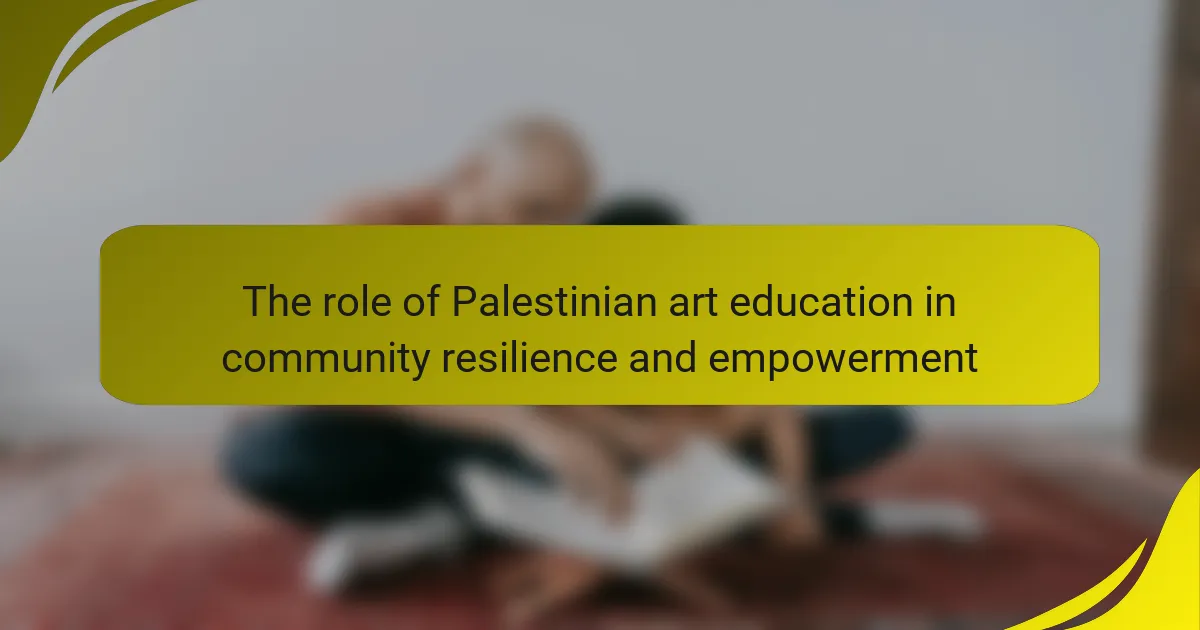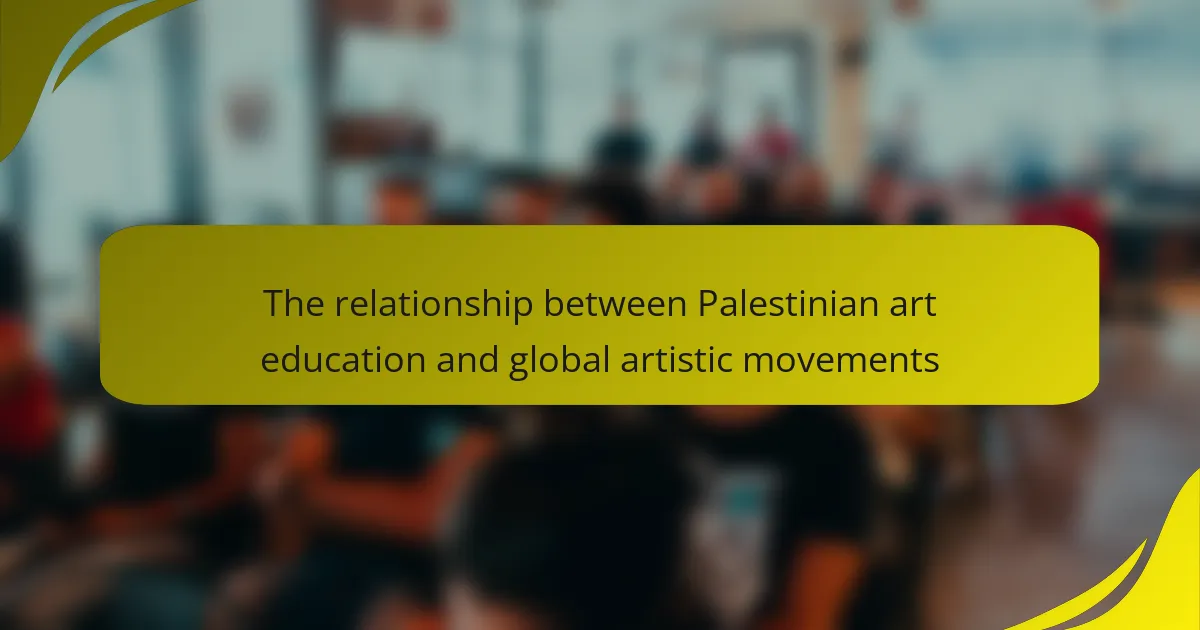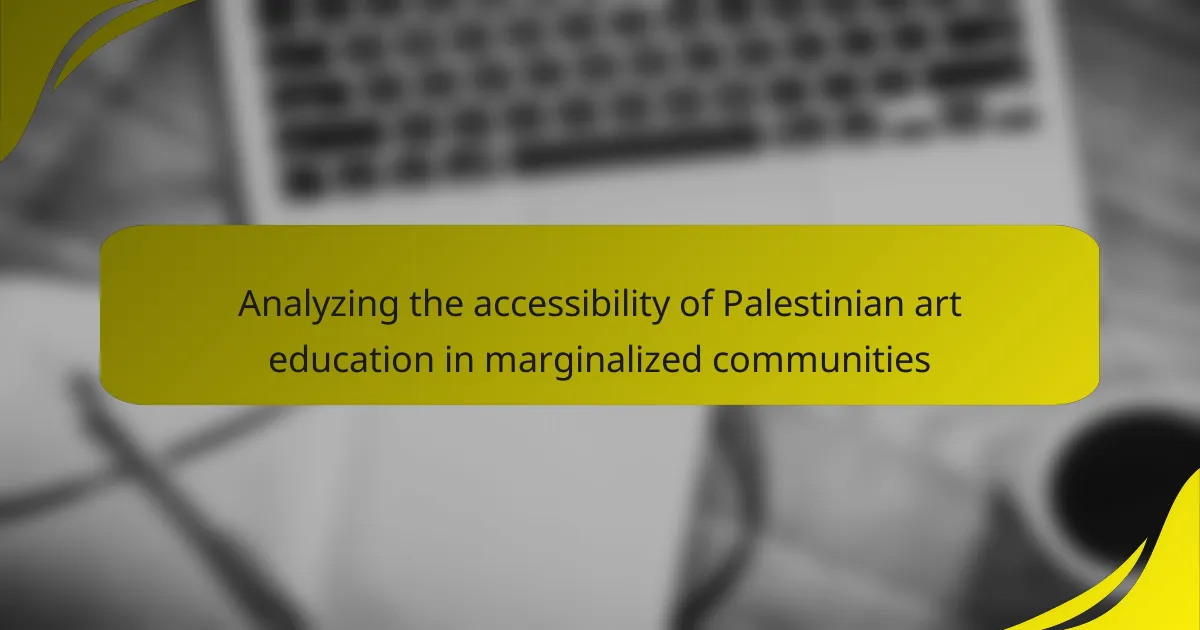Palestinian art education plays a crucial role in promoting intercultural dialogue and understanding among diverse communities. It fosters creativity and critical thinking, allowing students to express their cultural identities through various art forms. Collaborative projects and workshops facilitate communication between different cultural groups, helping to break down stereotypes and build mutual respect. Research indicates that art education enhances empathy and cultural awareness, essential for fostering peace in conflict-affected regions like Palestine. By integrating historical and contemporary art into the curriculum, students gain a deeper appreciation for diverse perspectives, ultimately contributing to community cohesion and intercultural understanding.
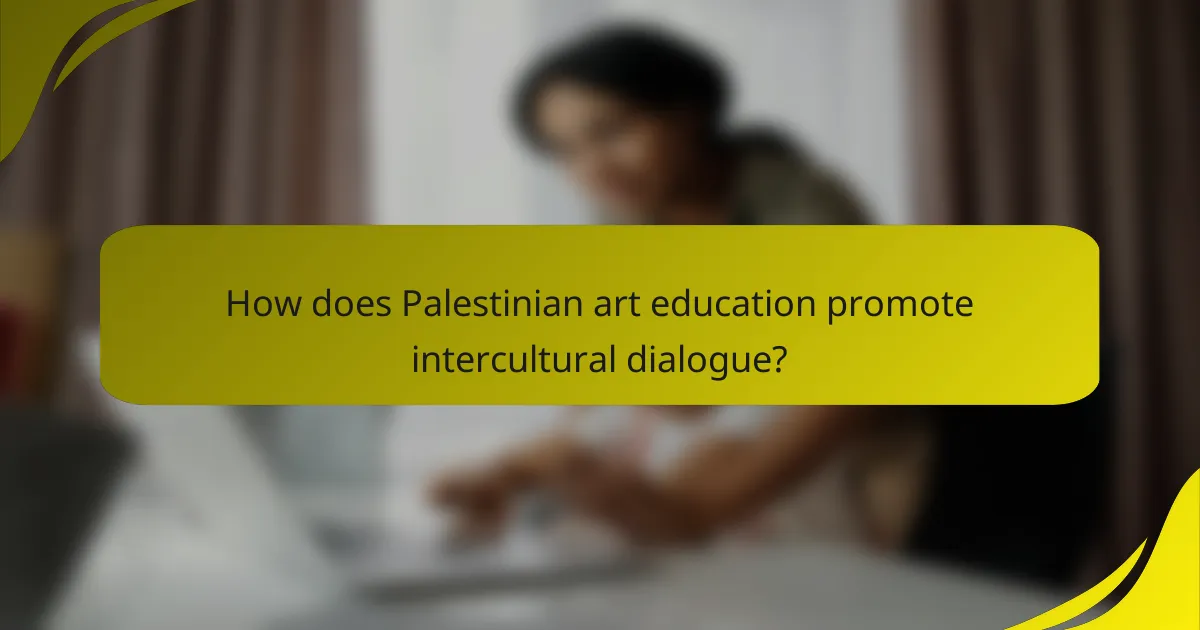
How does Palestinian art education promote intercultural dialogue?
Palestinian art education promotes intercultural dialogue by fostering creativity and critical thinking among students. It encourages students to express their cultural identities through various art forms. This expression opens channels for communication between different cultural groups. Collaborative projects often involve participants from diverse backgrounds. These projects help to break down stereotypes and build mutual respect. Workshops and exhibitions showcase a range of artistic perspectives. Such events invite dialogue and understanding among attendees. Research shows that art education can enhance empathy and cultural awareness. This is vital in conflict-affected regions like Palestine, where intercultural understanding is essential for peace.
What role does art play in fostering understanding between cultures?
Art serves as a vital medium for fostering understanding between cultures. It transcends language barriers and communicates emotions and ideas. Through visual representations, music, and performance, art conveys cultural narratives. This engagement encourages empathy and appreciation for diverse perspectives. Studies show that collaborative art projects enhance intercultural dialogue. For example, initiatives in Palestinian art education promote connections among different cultural groups. Such programs allow participants to share their stories and experiences. Ultimately, art cultivates a shared space for dialogue and mutual understanding.
How can art education bridge cultural divides?
Art education can bridge cultural divides by fostering understanding and appreciation of diverse perspectives. It encourages students to express their identities and experiences through creative mediums. This process promotes dialogue among individuals from different backgrounds. Collaborative art projects unite participants in shared experiences. Such initiatives help dismantle stereotypes and foster empathy. Research shows that art education enhances intercultural communication skills. Programs that integrate cultural themes encourage respect for differences. For example, the “Art for Peace” initiative in Palestine has successfully brought together students from varied backgrounds to explore common narratives through art. This approach cultivates a sense of community and shared humanity.
What specific art forms are used to promote dialogue?
Visual arts, theater, music, and literature are specific art forms used to promote dialogue. Visual arts, such as painting and sculpture, provide a medium for expression and cultural storytelling. Theater engages audiences through performance, encouraging discussion on societal issues. Music fosters emotional connections and shared experiences, bridging cultural divides. Literature, including poetry and prose, offers narratives that reflect diverse perspectives. Each of these forms can facilitate conversations and enhance understanding among different cultural groups. For instance, community art projects often involve collaboration, allowing participants to share their stories and experiences.
Why is intercultural dialogue important in the context of Palestinian art education?
Intercultural dialogue is important in Palestinian art education because it fosters understanding and respect among diverse cultures. This dialogue allows Palestinian artists to express their unique cultural narratives while engaging with global perspectives. It encourages collaboration and exchange of ideas, enriching the educational experience. Furthermore, intercultural dialogue helps to challenge stereotypes and misconceptions about Palestinian culture. Educational initiatives that promote this dialogue can enhance critical thinking and creativity among students. Research indicates that art education that includes diverse cultural viewpoints can lead to greater empathy and social cohesion. Therefore, intercultural dialogue is essential for cultivating a more inclusive and harmonious environment in Palestinian art education.
How does intercultural dialogue contribute to peace-building?
Intercultural dialogue contributes to peace-building by fostering mutual understanding and respect among diverse communities. It encourages open communication, which helps reduce stereotypes and misconceptions. Engaging in dialogue allows individuals to share their experiences and perspectives. This exchange can lead to conflict resolution and reconciliation. Studies show that communities involved in intercultural dialogue initiatives experience lower levels of violence. For example, the United Nations has reported that dialogue programs can significantly improve social cohesion. By promoting empathy, intercultural dialogue paves the way for collaborative peace efforts.
What challenges does Palestinian art education face in promoting dialogue?
Palestinian art education faces significant challenges in promoting dialogue. Limited resources hinder access to quality art education. Political instability restricts freedom of expression in artistic practices. Cultural censorship affects the content and themes explored in art. Socioeconomic barriers limit participation in art programs. Additionally, a lack of institutional support undermines the development of comprehensive art curricula. These factors collectively impede the potential for art to foster intercultural understanding and dialogue.
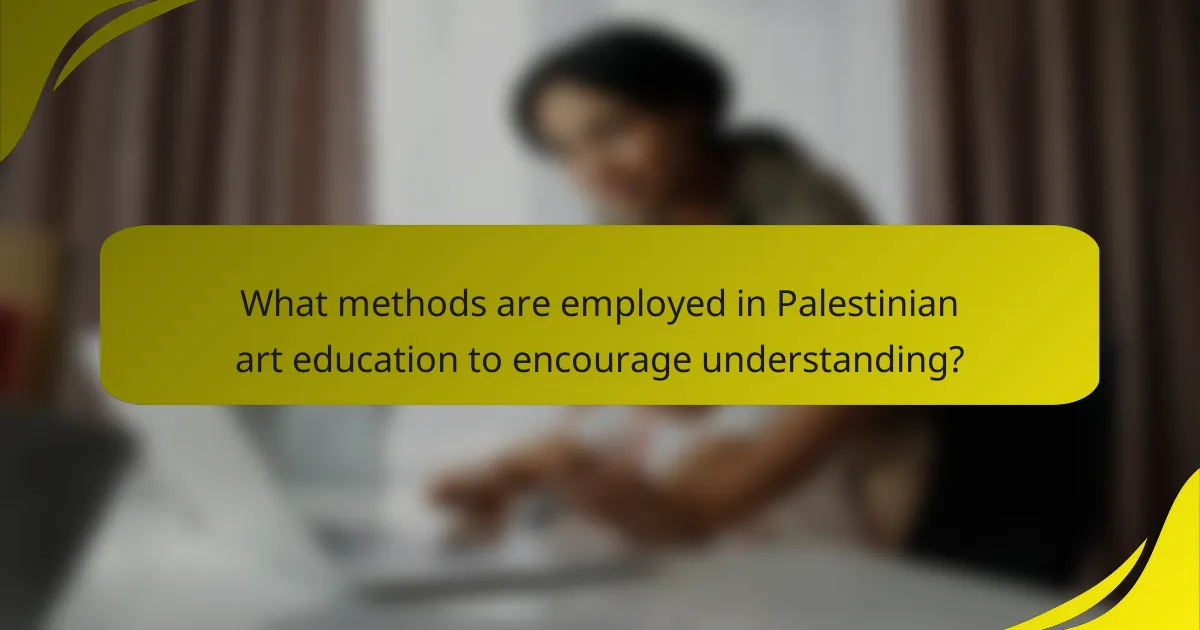
What methods are employed in Palestinian art education to encourage understanding?
Palestinian art education employs various methods to encourage understanding. These methods include collaborative projects that foster teamwork among students. Workshops and community art initiatives promote engagement with local culture. Curriculum integration of historical and contemporary art encourages critical thinking. Exposure to diverse artistic expressions enhances appreciation for different perspectives. Mentorship programs connect students with established artists for guidance. Art exhibitions serve as platforms for dialogue and cultural exchange. These approaches collectively aim to deepen understanding and appreciation of Palestinian identity and heritage.
How do collaborative art projects facilitate intercultural exchange?
Collaborative art projects facilitate intercultural exchange by bringing together diverse cultural perspectives. Participants share their unique backgrounds and experiences through artistic expression. This interaction fosters mutual understanding and respect among different cultures. Collaborative projects often result in artworks that blend various cultural elements, showcasing diversity. For example, a study by the University of Michigan found that such projects enhance social cohesion and cultural appreciation. Art serves as a universal language, breaking down barriers and encouraging dialogue. Participants often develop friendships that extend beyond the project, creating lasting connections. Overall, collaborative art projects act as a bridge between cultures, promoting empathy and shared experiences.
What are examples of successful collaborative projects?
Successful collaborative projects include the “Art and Freedom” initiative, which brings together Palestinian and Israeli artists. This project fosters dialogue through shared artistic expression. Another example is the “Cultural Bridges” program, which connects Palestinian youth with international artists. This initiative enhances cultural understanding and promotes peace through art. Additionally, the “Creative Connections” project pairs Palestinian schools with global art institutions. This collaboration enriches educational experiences and encourages intercultural exchange. Each of these projects demonstrates the power of art in bridging cultural divides.
How do these projects impact participants’ perspectives?
These projects significantly broaden participants’ perspectives. Participants often gain a deeper understanding of diverse cultures through artistic expression. Engagement in collaborative art projects fosters empathy and respect for differing viewpoints. Participants report increased awareness of social issues affecting various communities. Research shows that art education enhances critical thinking and open-mindedness. For instance, a study by the University of California found that art programs improve intercultural communication skills. Participants often reflect on their own identities in relation to others. This reflection leads to personal growth and enhanced intercultural dialogue.
What teaching strategies are effective in Palestinian art education?
Effective teaching strategies in Palestinian art education include project-based learning, collaborative art-making, and culturally relevant pedagogy. Project-based learning encourages students to engage deeply with their art projects. This method fosters critical thinking and creativity. Collaborative art-making promotes teamwork and communication among students. It allows for the exchange of diverse perspectives. Culturally relevant pedagogy connects art education to students’ cultural identities. This approach validates their experiences and enhances engagement. Research shows that these strategies improve student motivation and artistic skills. They also promote intercultural dialogue by incorporating diverse narratives and histories.
How does experiential learning enhance cultural understanding?
Experiential learning enhances cultural understanding by immersing individuals in diverse cultural contexts. This approach allows participants to engage directly with different cultural practices and perspectives. Through hands-on experiences, learners develop empathy and awareness of cultural nuances. Research shows that active participation in cultural activities fosters deeper connections and understanding. For example, a study by Kolb (1984) highlights how experiential learning promotes personal reflection and insight. This method encourages individuals to confront their biases and assumptions. Ultimately, experiential learning cultivates a more inclusive worldview and appreciation for cultural diversity.
What role do local traditions play in the curriculum?
Local traditions play a significant role in the curriculum by enriching educational content and fostering cultural identity. Incorporating local traditions helps students connect with their heritage and understand their community’s values. This approach promotes a sense of belonging and pride among learners. In Palestinian art education, local traditions are integrated into lessons, showcasing traditional techniques and themes. Research indicates that such integration enhances students’ engagement and creativity. For example, the use of local folklore in art projects allows students to express their cultural narratives. This method not only preserves local traditions but also encourages intercultural dialogue and understanding among diverse student populations.
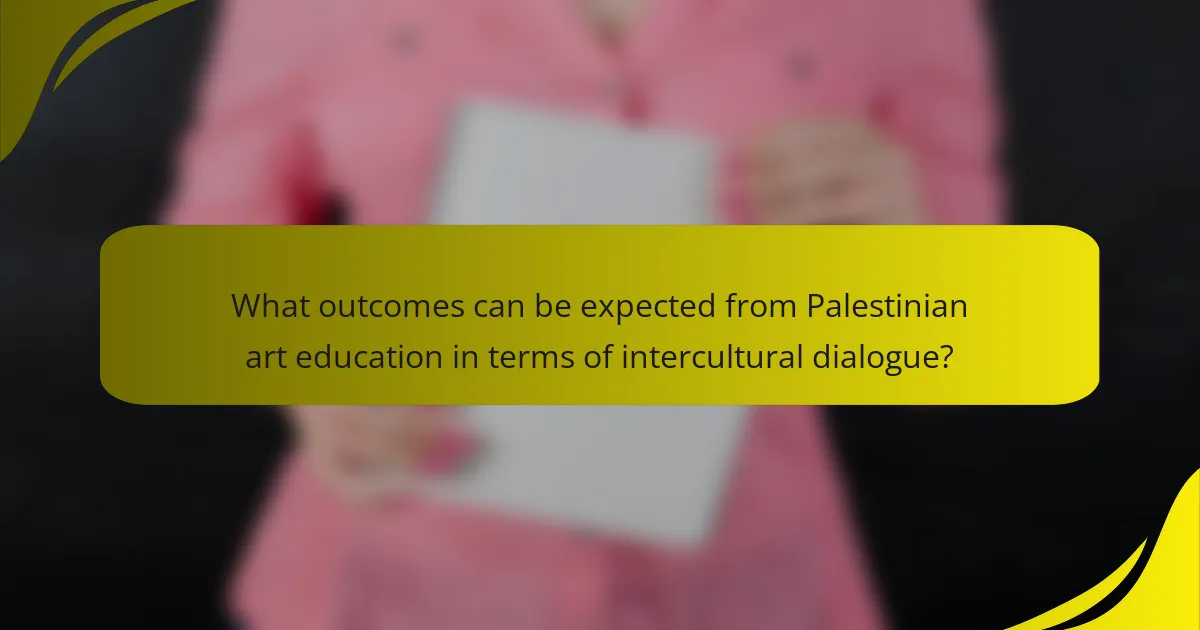
What outcomes can be expected from Palestinian art education in terms of intercultural dialogue?
Palestinian art education can foster intercultural dialogue by promoting understanding and empathy among diverse communities. It encourages students to explore their cultural identities while engaging with others. Through collaborative projects, students learn to appreciate different perspectives. Art serves as a universal language that transcends barriers. Workshops and exhibitions often bring together artists from various backgrounds. This interaction cultivates mutual respect and shared experiences. Research indicates that art education enhances communication skills, essential for dialogue. Programs that include multicultural curricula have shown positive outcomes in community cohesion.
How does participation in art education influence students’ worldviews?
Participation in art education significantly influences students’ worldviews by fostering creativity and critical thinking. Engaging in artistic expression encourages students to explore diverse perspectives. This exploration cultivates empathy and understanding towards different cultures. Research indicates that art education enhances cultural awareness and appreciation among students. For instance, a study by Hetland et al. (2007) found that students involved in arts education showed increased openness to new ideas. Consequently, art education helps students develop a more inclusive worldview. This transformation is particularly evident in multicultural settings, where students learn to appreciate diversity through collaborative projects. Overall, art education serves as a powerful tool for broadening students’ perspectives and promoting intercultural dialogue.
What skills do students develop that promote intercultural dialogue?
Students develop communication skills that enhance intercultural dialogue. These skills include active listening, which fosters understanding of diverse perspectives. Empathy is cultivated through engagement with different cultural narratives. Critical thinking allows students to analyze and appreciate varying viewpoints. Collaboration skills are strengthened through group projects involving diverse cultures. Cultural awareness is heightened by exploring various artistic expressions. Conflict resolution skills are developed through discussions on cultural differences. These skills collectively promote meaningful interactions across cultural boundaries.
How do these outcomes extend beyond the classroom?
Outcomes from Palestinian art education extend beyond the classroom by fostering intercultural dialogue and community engagement. Students apply artistic skills in public spaces, promoting cultural awareness. Collaborative projects with diverse groups enhance mutual understanding. Exhibitions and performances invite community participation, bridging cultural gaps. Research indicates that art education cultivates empathy and social cohesion. These activities contribute to a more inclusive society. Engaging with local and global audiences amplifies voices and narratives. Ultimately, the impact of art education resonates within communities, fostering lasting connections.
What are best practices for implementing art education programs that foster dialogue?
Best practices for implementing art education programs that foster dialogue include creating inclusive curricula. Inclusive curricula allow diverse perspectives to be shared. Engaging local artists can enhance relevance and connection to the community. Collaborative projects encourage interaction among participants. Facilitating open discussions about art promotes critical thinking. Providing training for educators on dialogue facilitation is essential. Establishing partnerships with cultural organizations can broaden outreach. Evaluating program impact helps refine strategies for future initiatives. These practices are supported by research indicating that inclusive and interactive art education fosters greater dialogue and understanding among participants.
How can educators create inclusive environments for diverse participants?
Educators can create inclusive environments for diverse participants by implementing culturally responsive teaching practices. This involves recognizing and valuing the diverse backgrounds of students. Incorporating diverse perspectives into the curriculum enhances engagement. Providing multiple forms of expression allows all students to participate. Creating a safe space for dialogue fosters mutual respect. Utilizing collaborative projects encourages teamwork among diverse groups. Training staff on inclusivity promotes awareness and sensitivity. Research shows that inclusive environments improve student outcomes and satisfaction.
What resources are available to support intercultural art education?
Resources available to support intercultural art education include educational programs, community workshops, and online platforms. Educational programs often focus on diverse cultural perspectives in art. Community workshops provide hands-on experiences that foster interaction among different cultural groups. Online platforms offer access to a wide range of resources, including lesson plans and teaching materials. Additionally, grants and funding opportunities support initiatives that promote intercultural understanding through art. Organizations such as UNESCO and local cultural institutions also provide valuable resources and support for educators. These resources collectively enhance the understanding and appreciation of diverse cultures through art education.
The main entity of the article is Palestinian art education, which plays a crucial role in promoting intercultural dialogue and understanding. The article explores how art education fosters creativity, critical thinking, and cultural expression among students, facilitating communication between diverse cultural groups. It highlights the importance of collaborative projects, various art forms, and experiential learning in enhancing empathy and respect for different perspectives. Additionally, the article addresses the challenges faced by Palestinian art education and outlines effective teaching strategies and best practices for creating inclusive environments that support intercultural exchange. Overall, it emphasizes the potential of art education to bridge cultural divides and contribute to peace-building efforts.
